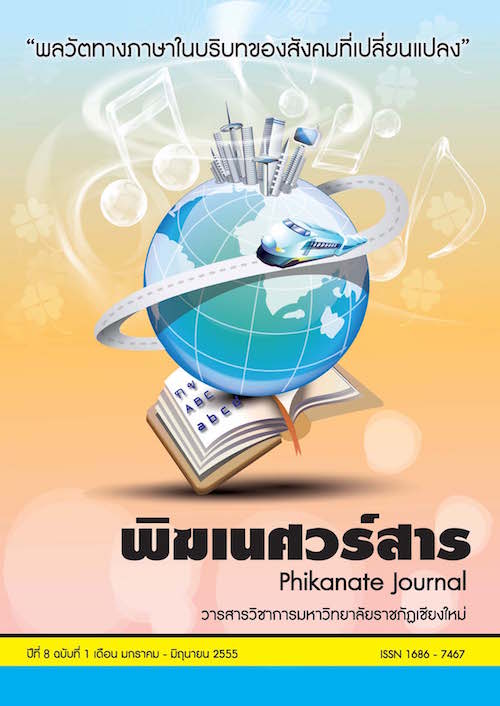สุนทรียภาพในบทโขน เรื่องรามเกียรติ์
Main Article Content
Abstract
ผลการวิจัยพบว่า สุนทรียภาพในคำของบทโขนเกิดจากการสัมผัสพยัญชนะซึ่งมีทั้ง 7 ประเภทและสัมผัสสระมีทั้ง 6 ประเภท การสัมผัสที่พบมากที่สุด คือ การสัมผัสพยัญชนะแบบคู่ และสัมผัสสระแบบเคียงส่วนสุนทรียภาพในคำรองลงมา คือ การสัมผัสพยัญชนะแบบเทียบคู่ส่วนการสรรคำที่พบมากที่สุด คือการใช้คำหลากการเล่นคำที่พบมาก คือการซํ้าคำ ส่วนสุนทรียภาพในความที่เกิดจากการใช้ภาพพจน์ ที่พบมากที่สุด คือ อุปมา รองลงมา คือ นามนัย โวหารที่พบมากที่สุด คือ บรรยายโวหาร รองลงมา คือ พรรณนาโวหาร ส่วนรสวรรณคดีทางสันสกฤตมีครบทั้ง 9 รส รสวรรณคดีที่พบมากที่สุด คือ รุทธรส รองลงมา คือ อัพภูตรส
ผลการวิเคราะห์เปรียบเทียบวรรณศิลป์ระหว่างบทโขนแบบโบราณกับแบบปัจจุบัน แบ่งเป็น 2 ด้าน พบว่า ด้านเนื้อเรื่อง บทโขนโบราณดำเนินเรื่องตาม คัมภีร์รามายณะของพระวาลมีกิพรหมฤษี ฉบับภาษาอังกฤษส่วนบทโขนปัจจุบันดำเนินเรื่องตามบทพระราชนิพนธ์ เรื่องรามเกียรติ์ในรัชกาลที่ 1, รัชกาลที่ 2 และรัชกาลที่ 6 ซึ่งทรงพระราชนิพนธ์มาจาก รามายณะ ฉบับสันสกฤต จึงมีความแตกต่างกันในชื่อของตัวละคร บทบาทและเนื้อเรื่องบางช่วงบางตอน บทโขนปัจจุบันมีการปรับเปลี่ยนถ้อยคำ สำนวน ลักษณะคำประพันธ์ ย่อเนื้อเรื่องให้กระชับขึ้น นอกจากนี้ยังมีการเพิ่มบทรำ บทตลก และสอดแทรกความรู้ด้านสุนทรียภาพ บทโขนโบราณมีการใช้สัมผัสพยัญชนะ 6 แบบ สัมผัสสระ 5 แบบ มีการเล่นเสียงวรรณยุกต์ มีการสรรคำด้วยการใช้คำหลาก เล่นคำด้วยการใช้คำซํ้า การซํ้าคำ การใช้คำสลับที่ การใช้คำพ้องภาพพจน์โวหารมี 4 แบบ และรสวรรณคดีมี 7 รสส่วนบทโขนปัจจุบันมีการใช้สัมผัสพยัญชนะ 7 แบบ สัมผัสสระ 5 แบบ มีการเล่นเสียงวรรณยุกต์ การสรรคำด้วยการใช้คำหลาก การเล่นคำด้วยการใช้คำซํ้า การซํ้าคำการใช้คำสลับที่ การใช้คำพ้อง โวหารภาพพจน์มี 6 แบบ รสวรรณคดีมี 7 รส นอกจากนี้แล้วบทโขนปัจจุบันได้มีการใช้วาทศิลป์ ที่เหมาะกับยุคสมัยและสถานการณ์ ดังนั้น จึงทำให้บทโขนมีสุนทรียภาพทางภาษาที่มีคุณค่ายิ่ง
Aesthetics of the Ramayana Masked Play Scripts
This thesis aimed to analyze aesthetics in the Ramayana masked play scripts, and to compare between old-styled and current-styled literatures . The research focused on analyzing the aesthetics in the 45 masked play scripts issued by the Office of Performing Arts, Fine Arts Department, the Ministry of Culture, and on comparing the differences between the 6 masked play scripts written by King Rama VI and present ones in both the stories and their aesthetics. The thesis was analyzed in descriptive analysis. The results found that the aesthetics in wording was caused by 7 rhyming consonants 6 rhyming vowels. Rhythms mostly found were paired- rhyming consonants and available rhyming vowels while the runners-up were paired-compared rhyming consonants. As for selected words mostly found were various kind words, and playing-on words mostly found were repeated words. The aesthetics in context mostly found was metaphor while metonymy was a runner-up. The phrase mostly found was descriptive phrase with a runner-up vivid descriptive phrase. While literary taste in the scripts found were 9 kinds of Sanskrit literary taste. The literary taste mostly found was anger taste while the runner-up was exiting taste. From the comparison between old-styled and current-styled scripts, the research found 2 sides : subject and aesthetics matters. In the subject matter of the old-styled scripts, it followed the epic Ramayana written by Valmiki in English, while the current-styled scripts were from the royal literary works called the epic Ramakian written by King Rama 1, 2 and 6 from the Sanskrit Ramayana. In the current-styled scripts, there were adjustments of wording, idioms, the styles of poetry writing, story shortening and omission of subject matter; besides, more dancing, comedy and inserted knowledge were added, so, there were differences of the names and roles of the characters, and of the story in some chapters. In the aesthetics matter of the old-styled scripts, there were 6 rhyming consonants and 5 rhyming vowels while the current-styled scripts, there were 7 rhyming consonants and 5 rhyming vowels, but both had the same sound tones consonants, selected words, playing-on words by using various kind words, repeated words, word repetition, word switching and synonyms. For the sake of the image s of rhetoric phrases, there were 4 types in the old-styled scripts while there were 6 in the current-styled ones. There were 7 literary tastes in both scripts. Moreover, the current-styled scripts used more polite and chance-suited wording. Anyway, both the old and current-styled scripts showed valuable language image aesthetics.
Downloads
Article Details
The articles published are copyrighted by the Graduate School, Chiang Mai Rajabhat University.
The opinions expressed in each article of this academic journal are solely those of the individual authors and do not reflect the views of Chiang Mai Rajabhat University or its faculty members. The responsibility for the content of each article rests entirely with the respective authors. In the event of any errors, the authors alone are responsible for their own articles.


